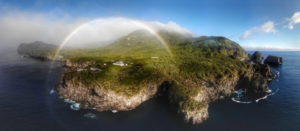
Gough Island by drone. RSPB, C. Jones
June 6,2021
Gough Island? Where’s that? And who cares?
Gough (pronounced GOFF), a UNESCO World Heritage Site, is one of several dollops of land in the South Atlantic Ocean, about equidistant from South Africa, South America, and South Georgia Island. Gough is about 8 miles long and 4 miles wide, a tad smaller than Kahoolawe. The UK claimed Gough in 1938, naming it after Charles Gough, the captain of the British ship that arrived there in 1732.
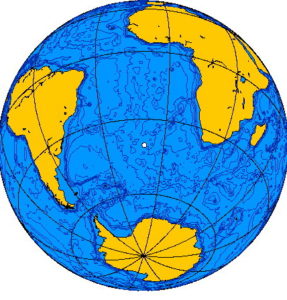
Gough Island (white spot) is one of several volcanic islands in the South Atlantic’s British Overseas Territory. The nearest human-inhabited island is Tristan de Cunha, about 260 miles northwest, with 250 residents. The islands have no airstrips, making them accessible only by boat.
So who cares? The entire world of bird lovers and naturalists. Gough Island hosts over 8 million breeding birds of 24 species, including endangered albatrosses, penguins, petrels, prions (a kind of petrel) and two endemic ground birds. Gough also supports the largest breeding population of sub-Antarctic fur seals, about 300,000, or 80 percent of the world population.
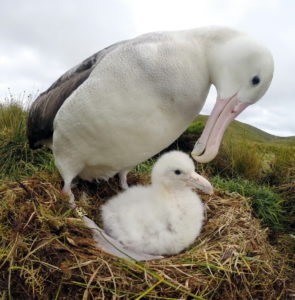
A critically endangered Tristan Albatross, Diomedea dabbenena, on Gough Island broods its downy chick. Photograph by Michelle Risi, Gough Island Restoration Program. (Shared with me by John Cooper of South Africa.)
But there’s a human-caused disaster on this and other seabird colonies, a calamity that makes bird enthusiasts, researchers, and environmentalists worldwide wince at the mention of Gough Island, where the problem is rampant. In the 1800s, sailors accidentally introduced house mice to the island. Over the decades, the mice have multiplied, and with limited seeds and plants to eat, the mice learned to eat bird eggs and chicks.
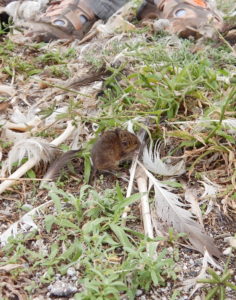
Midway also has a mouse problem. This Midway mouse is scavenging the bones of a long-dead albatross. The mice have become so abundant on Midway’s Sand Island, they scurried around our shoes (top of photo) as we counted albatrosses. Susan Scott photo, January 2020.
The meat-eating mice of Gough are now about 50% larger than standard house mice, and are killing over 2 million chicks a year. Because ground-and-burrow-nesting birds evolved with no predators, the birds sit still for their slow death, eaten alive, bite by bite, sometimes by whole gangs of mice. The photos are gruesome. I’ll share video links to view as much as your stomach and heart can stand, and will show these to the people who oppose rat and mouse eradications.
Gough: youtube.com/watch?v=ePmlPpNND_g
Midway: youtube.com/watch?v=B7iv81LDILU
But there’s a bright side to this dark story. The UK’s Royal Society for the Protection of Birds, rspb.org.uk/ working with an impressive number of international organizations, goughisland.com/partnership, raised millions of dollars, and organized teams of experts from New Zealand, Australia, the U.K., South Africa, Mexico, and the U.S. to eradicate the mice: goughisland.com/ It’s the humane thing to do for the birds as well as the mice, because once they’ve killed off the last of the birds, the mice will starve to death.
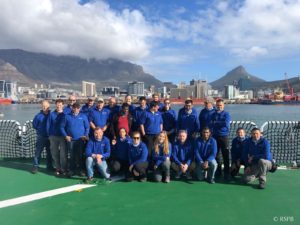
The fourth and final international Gough Restoration team on the deck of the Argulhas II in Cape Town harbor just before last week’s departure. My husband, Craig Thomas, the team physician, is standing, second from right.
This enormous effort was postponed last year due to Covid-19, but the seabird rescuers have regrouped and are going for it in spite of difficulties presented by the pandemic. Time is of the essence. The mice-gone-bad are now eating adult birds as they sit on eggs and warm their newborn chicks. With adults now being killed, without intervention, extinction of several species is imminent.
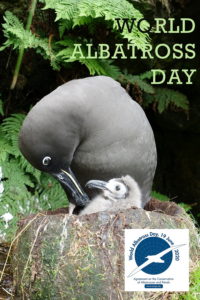
This endangered Sooty Albatross, Phoebetria fusca, tending its chick was the poster bird for the 2020 World Albatross Day. Photograph by Michelle Risi, Gough Island Restoration Program
The good news is that as I write, the fourth and final team that sailed from Cape Town last week have arrived and are currently unloading the ship, a 440-foot-long South African research vessel called the Agulhas II. The cargo includes 4 helicopters, supplies for about 50 people through August, and tons of bait pellets the helicopters will drop island wide. The bait contains an anticoagulant that kills a mouse painlessly in about 24 hours.
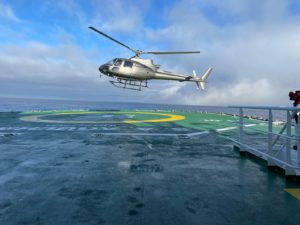
One of the four helicopters transported by ship to Gough Island. The ship’s helipad is below. Craig Thomas photo.
Gough’s latitude is 40.3 degrees south, putting it at the edge of the Southern Ocean’s notorious roaring 40s, where winds can blow 70 miles per hour and fog is common. Because helicopters can’t fly in those conditions, the dates of the drops, and the length of the project, is weather dependent. Longest-case scenario is the end of August.

Helicopters transport supplies from the ship to Gough Island, which has no harbor. The 4 helicopters will make about 400 trips combined to get all the gear ashore. Craig Thomas photo.
Because storms approach South Africa from the southwest, the South Africa government manages a weather station on Gough, employing 6 people who live and work there for a one-year term. It’s usually a lonely outpost that just got crowded. Among that crowd is my husband, Craig Thomas, the team physician for this phase of the project. Because Craig has a satellite phone that allows him to sometime send texts with photos, I’m able to personally follow this ambitious, worthy, and amazing effort to save a large number of the world’s most magnificent seabirds. We can also can follow progress at goughisland.com/blog
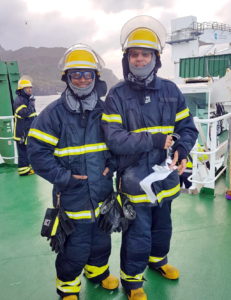
Craig (right) and a UK physician, Hareen, are assigned duties when not doctoring, which will hopefully be rare and minimal. During the ship unloading, they are stand-by firemen. On island, they will be bait loaders, lifting 50-pound bags of mouse bait onto helicopters.
What happens at Gough will not stay on Gough. The success of this project has huge implications for other islands with the same issue, including Midway, where mice have also started eating albatrosses alive. Rats were eliminated from Midway in 1996, but the mice have gradually taken their place, a natural development for the introduced, omnivorous rodents where they have no predators. The U.S. Fish and Wildlife Service, with some of the same partners of the Gough project, is also organizing a mouse eradication program for Midway in 2022. The Gough effort will give scientists in these organizations valuable information for the bird rescue program at Midway and other islands around the world.
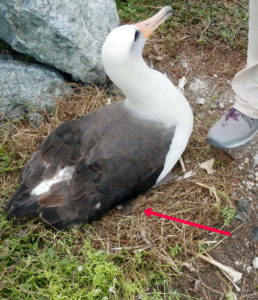
A Midway mouse nestles next to a resting Laysan albatross, fearless of mice as well as people. The appearance of the nocturnal mice during the day, and in the presence of people, indicate their abnormal abundance. We workers saw bloody wounds on several birds. ©Susan Scott
Gough Island may be on the opposite side of the planet and in the opposite hemisphere from Hawaii, but some of our islands are also among the few places left for seabirds to safely raise their young. That we are sister islands in conservation is a good reason for us in Hawaii to care about what happens at Gough.
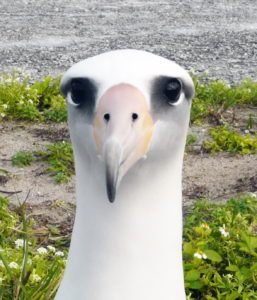
A Laysan albatross, Midway Atoll. ©Susan Scott